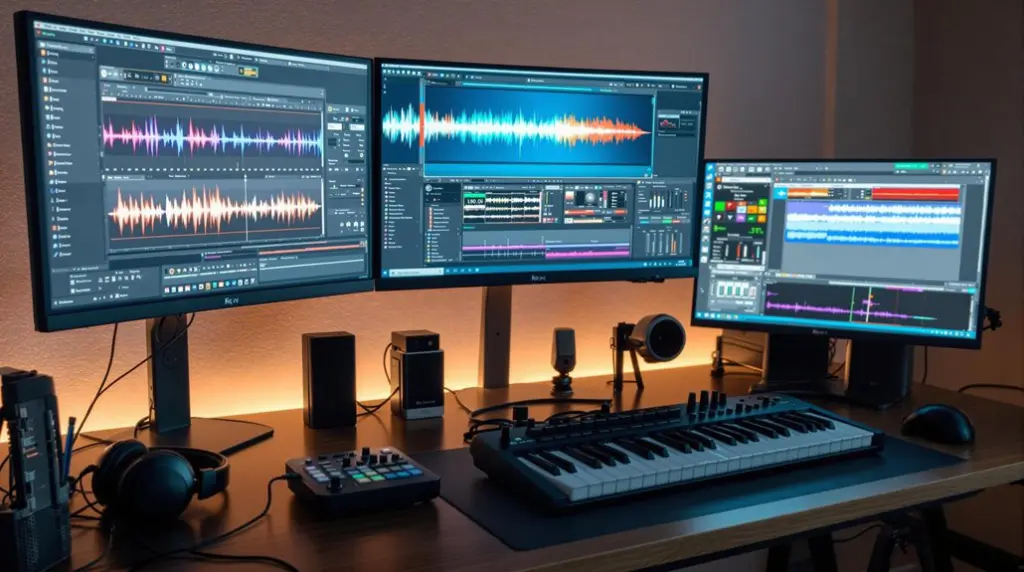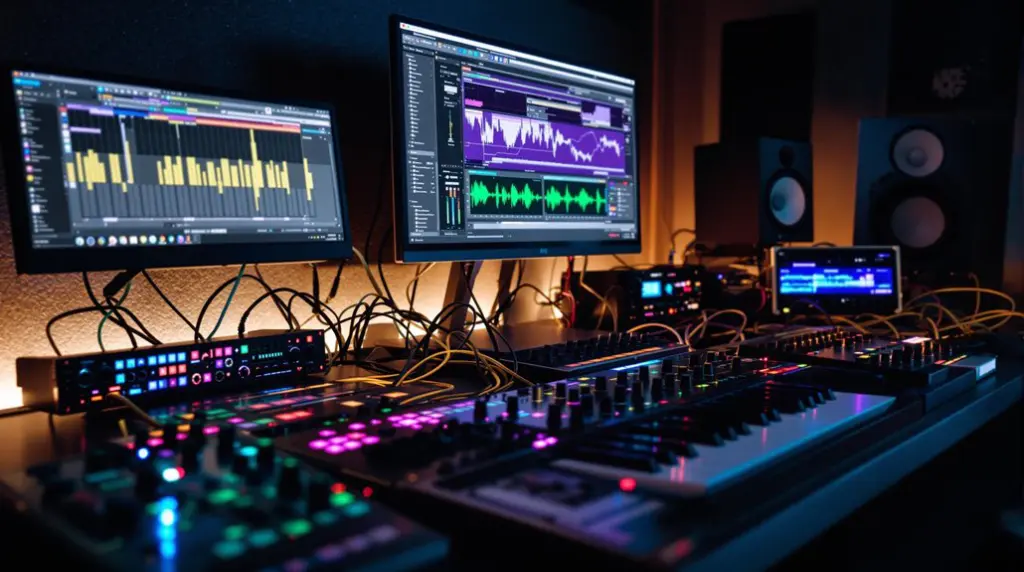The Waldorf Quantum synthesizer stands out due to its high-resolution touchscreen interface, which enhances detailed sound programming, and its versatile synthesis engines, including wavetable, waveform, particle, and sampling options. The robust build quality, featuring a Fatar TP8S keybed and ergonomic design by Axel Hartmann, guarantees reliability and a premium tactile experience. Advanced modulation matrix capabilities with 40 slots and integration of polyphonic aftertouch offer extensive sound sculpting flexibility. Superior filter and effects sections, including dual analogue filters and diverse processing types, boost audio manipulation. Thorough connectivity options and performance-focused sequencing features further solidify its professional utility. Explore these features to see why Quantum is an indispensable tool.
Key Takeaways
- High-resolution touchscreen and OLED display enhance user interface and visual feedback.
- Four versatile synthesis engines enable extensive sound design possibilities.
- Advanced modulation matrix with 40 slots and 43 sources for complex sound sculpting.
- Sturdy build with a high-grade Fatar TP8S keybed ensures durability and playability.
- Extensive connectivity options support seamless integration in studio and live settings.
High-Resolution Touchscreen Interface
The Waldorf Quantum’s high-resolution touchscreen interface greatly enhances the user experience by providing precise and intuitive control over the synthesizer’s extensive sound design capabilities. The high-definition OLED display offers superior viewing angles compared to traditional LCDs, ensuring that users can clearly see and interact with the interface from various positions. This touchscreen responsiveness is critical for detailed sound programming and efficient maneuvering through complex menus.
The Quantum’s interface is on par with some of the top music production software for its intuitiveness and advanced control.
The user interface design is meticulously crafted to facilitate seamless access to essential features such as oscillators, LFOs, and routing options. The layout’s clarity minimizes the need for extensive physical controls, streamlining the workflow and making the synthesizer more approachable.
Adjustable LED indicators provide real-time visual feedback on user-selected parameters, greatly enhancing the usability and engagement of the interface.
Despite some reports of challenges with touchscreen accuracy, particularly from users with larger fingers, the overall design succeeds in delivering an engaging and efficient user experience. The Quantum’s interface fosters quick sound design sessions, reducing the time spent maneuvering through settings and allowing users to focus on creative output.
Versatile Synthesis Engines
Few synthesizers on the market today can match the Waldorf Quantum‘s versatility, thanks to its four independent synthesis engines: Wavetable, Waveform, Particle, and Sampling. Each of the Quantum’s three oscillators provides access to these engines, enabling sound designers to explore diverse tonal landscapes.
The Wavetable engine boasts 85 factory wavetables and allows for custom wavetable creation from text or audio files, offering near limitless sound shaping capabilities. This feature alone positions the Quantum as a leading tool for contemporary electronic music production. Regular updates on new techniques and tools from industry professionals can further enhance the Quantum’s capabilities.
The Particle engine excels in granular manipulation, leveraging a 1GB sample library expandable via SD cards. This engine facilitates intricate and detailed sample transformations, making it a powerful asset for creating evolving textures and ambient soundscapes.
The Sampling engine, on the other hand, guarantees precise playback and layering of audio material, perfect for both traditional and experimental uses.
Quantum’s Resonator oscillator, though less documented, invites users into an area of experimental sound design, promoting unique and innovative sonic results. The ability to combine these various synthesis methods within its architecture underscores the Quantum’s unparalleled flexibility and depth, providing sound designers with a robust platform for complex, evolving soundscapes.
Advanced Modulation Matrix
The Waldorf Quantum’s advanced modulation matrix, boasting 40 slots, enables complex sound sculpting through its extensive range of 43 modulation sources and 158 destination options.
This sophisticated framework, augmented by polyphonic aftertouch integration, allows for highly expressive and dynamic modulation capabilities that respond intuitively to nuanced key play.
Upcoming updates promise to enhance user efficiency in managing extensive modulation configurations, further solidifying the Quantum as an indispensable tool for professional sound designers.
Extensive Modulation Sources
Frequently lauded for its extensive modulation capabilities, Waldorf Quantum’s robust modulation matrix stands as a cornerstone for advanced sound design. The Quantum features an impressive 40-slot modulation matrix, providing users with the ability to assign a wide range of modulation sources to various destinations. This versatility in modulation techniques is essential for intricate and dynamic sound sculpting.
The Quantum offers 43 different modulation sources, including contour generators, LFOs, and MIDI Continuous Controllers (CCs). These sources enable a flexible approach to sound design, allowing for nuanced adjustments and complex modulations that can evolve over time. The inclusion of polyphonic aftertouch further enhances expressive performance, allowing players to infuse their soundscapes with detailed, real-time modulation.
With 158 potential destination options within the modulation matrix, users can create sophisticated modulation setups that transform sounds dynamically. Whether targeting filter cutoffs, oscillator parameters, or effects, the modulation possibilities are virtually limitless.
Future updates promise to enhance user efficiency in maneuvering these extensive lists, ensuring that the modulation experience remains intuitive and powerful.
Versatile Destination Options
Among its standout features, the Waldorf Quantum boasts a modulation matrix with 158 versatile destination options, facilitating advanced sound design and intricate modulation routing. This extensive array of destinations allows for unparalleled modulation creativity, empowering users to sculpt and shape sounds with extraordinary precision.
The Quantum’s 40-slot modulation matrix is a significant tool for sound exploration, enabling complex and dynamic signal paths that can transform basic waveforms into intricate auditory landscapes.
With 43 modulation sources at the user’s disposal, including contour generators, LFOs, and MIDI CCs, the possibilities for sound manipulation are virtually limitless. Each source can be routed to any of the 158 destinations, which encompass parameters such as oscillator pitch, filter frequency, and amplitude.
This high degree of customization guarantees that even the most nuanced aspects of a sound can be modulated in real-time, offering a level of detail that is essential for professional sound design.
The modulation matrix’s support for polyphonic aftertouch further enhances its expressive capabilities, allowing for real-time, dynamic alterations during performance.
Future updates promise to expand these capabilities even further, with potential MPE (MIDI Polyphonic Expression) compatibility, making the Waldorf Quantum a continuously evolving powerhouse in the domain of electronic music production.
Polyphonic Aftertouch Integration
Building on its versatile destination options, the Waldorf Quantum’s integration of polyphonic aftertouch greatly amplifies its modulation matrix capabilities, providing an advanced level of expressive control. This sophisticated feature allows each key to send individual pressure information, markedly enhancing expressive performance capabilities.
By leveraging the polyphonic aftertouch within its 40 modulation matrix slots and 43 sources, users can dynamically control a vast array of sound parameters, enriching the sound design potential.
The polyphonic aftertouch’s ability to modulate parameters such as pitch, filter cutoff, and amplitude on a per-key basis allows for highly nuanced and intricate performances. This level of control is further augmented by the planned MPE (MIDI Polyphonic Expression) compatibility, which promises even greater depth and precision in expressive performance.
Such integration guarantees that the Quantum is not only a powerful tool for sound design but also a formidable instrument for live performance scenarios.
Ultimately, the advanced modulation matrix, bolstered by the inclusion of polyphonic aftertouch, positions the Waldorf Quantum at the forefront of modern synthesizers. It caters extensively to the demands of contemporary musicians, who seek both sophisticated sound design capabilities and unparalleled performance expressiveness.
Superior Filter and Effects
The Waldorf Quantum synthesizer stands out in the domain of professional music production due to its superior filter and effects capabilities.
At its core, the Quantum features dual analogue filters per voice, providing both 12dB and 24dB low-pass filtering options. This dual filter design offers unparalleled flexibility in sound shaping, with each filter independently controlled for cut-off and filter resonance. The ability to fine-tune resonance is particularly essential for achieving a wide range of sonic textures, from subtle warmth to aggressive peaks.
Complementing the analogue filters, the Digital Former incorporates 23 distinct processing types, including comb, high-pass, band-pass, notch, and bitcrusher. This array of digital processing options allows for extensive signal manipulation, broadening the creative palette for sound designers.
The effects section is also meticulously crafted, consisting of five blocks: phaser, chorus, flanger, delay, and reverb. Although only one instance of each effect can be used at a time, this limitation encourages thoughtful effects selection, ensuring each effect is employed to its maximum potential.
The inclusion of a built-in global compressor further enhances the Quantum’s output, ensuring well-balanced and professional-quality audio suitable for a range of musical applications. Additionally, the Quantum’s subtle compression capabilities help maintain the integrity of the tone while enhancing character.
Robust Build and Design
The Waldorf Quantum exemplifies robust build quality, featuring a high-grade Fatar TP8S semi-weighted keybed that guarantees a responsive and tactile playing experience.
Its sturdy construction, with dimensions of 1006 x 401 x 131 mm and a weight of 17.8 kg, offers durability suitable for both live performances and studio environments.
Additionally, the ergonomic control layout, combined with Axel Hartmann’s design and adjustable color-coded LEDs, enhances both usability and aesthetic appeal, providing musicians with an intuitive interface.
High-Quality Keybed
Crafted with precision, the Waldorf Quantum’s high-quality Fatar TP8S keybed sets a new standard in tactile responsiveness and durability, making it a sought-after feature for professional musicians. The keybed sensitivity is paramount, providing an unparalleled playing experience that captures every nuance of the performer’s touch. This attention to detail enables expressive dynamics, whether in delicate pianissimo passages or forceful fortissimo sections.
The semi-weighted feel of the TP8S keybed strikes an ideal balance between the resistance of fully weighted keys and the agility of unweighted keys. This makes it highly versatile, accommodating a wide range of musical genres, from classical to electronic. The semi-weighted design is particularly beneficial for executing rapid note sequences and complex articulations, ensuring that the Quantum responds accurately to the performer’s intentions.
Designed by Axel Hartmann, the Quantum’s aesthetic elegance is matched by its functional excellence. The control layout is intuitively integrated with the keybed, promoting an efficient and immersive workflow. This seamless integration allows musicians to navigate and manipulate sound parameters effortlessly, further enhancing the creative process.
Sturdy Construction Materials
While the high-quality Fatar TP8S keybed markedly enhances the Waldorf Quantum’s playability, its robust construction materials ascertain the synthesizer’s durability and reliability in demanding professional environments.
Weighing in at 17.8 kg, the Quantum’s substantial build underscores its resilience, a critical factor for both studio settings and live performances. The dimensions of 1006 x 401 x 131 mm contribute to its commanding presence, ascertaining stability and robustness.
The synthesizer’s design, spearheaded by Axel Hartmann at Design Box, integrates an elegant and modern aesthetic with practical engineering. The material selection process underwent rigorous durability testing to ascertain the Quantum could withstand the rigors of professional use.
The initial production issues, including display and keyboard flaws, have been adeptly resolved, aligning with high standards of quality and reliability.
Further enhancing its user experience, the Quantum features customizable LED colors and a quick boot time, merging functionality with visual appeal.
This meticulous attention to detail in material selection and construction not only reinforces the Quantum’s durability but also amplifies its appeal to both musicians and visual designers, affirming its status as a reliable and visually striking instrument.
Ergonomic Control Layout
In relation to ergonomic control layout, Waldorf Quantum exemplifies superior design with its strategically placed controls that guarantee seamless maneuverability during performances. The synthesizer, engineered by Axel Hartmann, features an intuitive design that emphasizes user accessibility. This is evident in the meticulously arranged control panel, which includes adjustable color-coded LEDs, enhancing visibility and facilitating quick identification of various functions, even in low-light environments.
The robust build, with dimensions of 1006 x 401 x 131 mm and a weight of 17.8 kg, ensures the Quantum remains stable during intensive use. The inclusion of a high-quality Fatar TP8S semi-weighted keyboard offers responsive playability, thereby augmenting the tactile experience for the performer.
Additionally, the user-friendly touchscreen interface provides a clear and responsive platform for intricate programming of oscillators, LFOs, and routing, streamlining the workflow for sound designers and musicians alike.
Dedicated controls for arpeggiator and chord functions are seamlessly integrated into the layout, allowing for intuitive access to these essential performance features. The ergonomic design not only supports prolonged use without fatigue but also enhances the overall efficiency, making the Waldorf Quantum a paragon of user-centric engineering in the synthesizer market.
Comprehensive Connectivity Options
Guaranteeing seamless integration into both studio and live environments, the Waldorf Quantum boasts an extensive array of connectivity options designed to meet the demands of professional musicians and producers. Central to its versatility are the unbalanced main and auxiliary outputs, which provide robust signal routing capabilities essential for complex setups.
These outputs guarantee the Quantum can be easily incorporated into any signal chain, whether in a recording studio or during a live performance. Furthermore, similar to Audio Units plugins in Logic Pro X, the Quantum’s integration is designed for stability and efficiency.
MIDI integration is another standout feature, facilitated by both USB Type A and Type B ports. The USB B port is exclusively dedicated to MIDI, guaranteeing efficient and reliable data transmission without audio interference. This allows for hassle-free connection to other MIDI-enabled devices, expanding the Quantum’s utility across various digital audio workstations and performance rigs.
Additionally, the Quantum’s rear panel includes stereo audio inputs and control inputs for sustain and expression pedals, offering nuanced control over performance dynamics. The dedicated headphone output with its own volume control guarantees that sound designers and performers can fine-tune their audio experience in isolation.
This thorough suite of connectivity options underscores the Waldorf Quantum’s capability to adapt to a wide range of professional audio environments.
Performance and Sequencing Features
The Waldorf Quantum excels in its performance and sequencing features, catering to the needs of professional musicians and producers who demand precision and flexibility. Central to this capability is the 32-step sequencer, which includes swing functionality and multiple modulation destinations. This allows for the creation of intricate rhythmic patterns, enhancing the user’s rhythmic creativity in both studio and live performance settings.
The sequencer’s ability to transmit MIDI messages guarantees seamless integration with other MIDI-enabled devices, broadening its versatility in complex production environments. Additionally, utilizing real-time digital song request services can further align live performances with audience preferences.
Additionally, the Quantum’s versatile arpeggiator offers seven distinct modes, such as chord and random, providing extensive melodic development options. This affords musicians the ability to experiment with diverse arpeggiations, further enriching their live performance and compositional processes.
The performance panel is another standout feature, allowing extensive parameter assignability. This enables real-time sound manipulation, making it an invaluable tool for live performance scenarios where dynamic sound alteration is essential.
Moreover, the polyphonic aftertouch capability adds a layer of expressive potential, enabling nuanced control over sound through touch sensitivity on the keyboard. This feature greatly enhances the emotional and dynamic range of performances, making the Waldorf Quantum a powerful instrument for both studio production and live shows.
Frequently Asked Questions
How Big Is the Waldorf Quantum?
The Waldorf Quantum’s physical dimensions are 1006 mm in width, 401 mm in depth, and 131 mm in height. In size comparison, it is relatively portable for a flagship synthesizer, facilitating both live performances and studio applications effectively.
Conclusion
In summation, the Waldorf Quantum synthesizer distinguishes itself through its high-resolution touchscreen interface, versatile synthesis engines, advanced modulation matrix, superior filters and effects, robust build and design, thorough connectivity options, and extensive performance and sequencing features. These attributes collectively render it an exemplary instrument for professional musicians and sound designers, epitomizing innovation and technical excellence in the field of modern synthesis technology.




